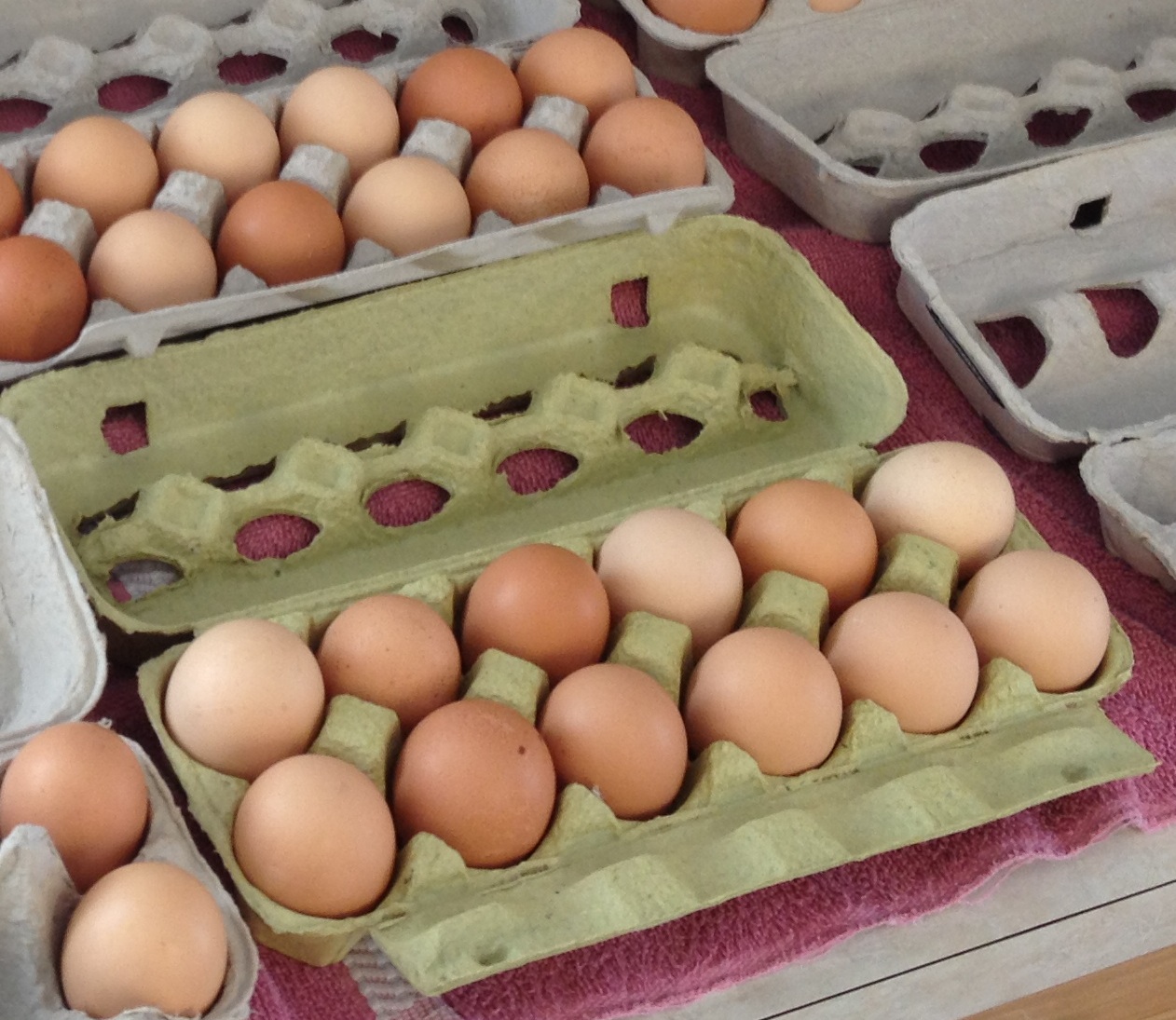This just in: We’re clucking crazy about laying hens.
In 2013 alone, Suzanne McMinn’s Chickens In The Road and Lisa Steele’s Fresh Eggs Daily were each best selling books, and the cover of Kristin Kimball’s hit farmoir The Dirty Life pictured her with a chicken cradled beneath one arm. Murray McMurray’s hatchery is so nice they named it twice, and within its glorious website one can order breeds as whimsical as Silver Laced Wyandottes to sturdy New Hampshires to fanciful Blue Andalusians.
But as Josh Vaillancourt explains in his excellent (ok, ok, eggscellent) article Small Farm Egg-Onomics, romantic notions of chicken ownership frequently wither beneath the gaze of financial scrutiny. Though I’ve raised laying hens for decades, our farm remains just as vulnerable to these economic realities as any upstart poultry ingenue. So now that Josh has provided a healthy dose of dollars and cents, allow me to ‘lay’ a few hard-won opinions on you.
1) Everyone loves chickens… as long as they’re laying
How well did your hens perform this year? 75% laying rate? 70%? Because if your percentage was less than 70, chances are you’re losing money… an experience I know all too well. A farmer can easily work three, four or five hours each day doing everything right, hauling water, gathering eggs, pitchforking the bedding. Yet there’s still no magical button that will make our hens lay. How can we best stack the deck in our favor?
Ironically, it was the Byrds who sang “To everything, turn, turn, turn.” I’ve never met a newbie chicken farmer who wants to hear this, but my most profitable years are when the hens are strictly culled after twelve months, and immediately replaced with a new flock. (An even better idea is to stock hens at 6 month intervals, so there’s no lapse in cash flow if they unexpectedly slow down early). As most chicken farmers know, hens lay considerably fewer eggs in year two. On our farm, older birds are processed and sold as stew hens for $12 apiece. In our nearby urban market, we can’t come close to meeting demand.
By definition, laying hens must lay. Our customers are more than happy to pay for authentic free-range eggs and flavorful stewing hens. But when it comes to excuses and disappointment, they refuse to pay me a nickel.
2) Chickens are big fat Time Vampires
Things I Like: Opening a gate into a new pasture, and watching my cattle eat grass instead of buckets of grain. Checking on my pigs, knowing that none have been eaten by hawks. Filling the lambs’ salt tub, without discovering they’ve gobbled up their own eggs.
Do you see where I’m going with this? Chickens are ‘Time Vampires,’ sucking energy, resources and opportunities away from many farms. While cattle, pigs and sheep undoubtedly have their own share of problems, compared to everything that can go wrong with chickens, raising these species seems practically effortless. With 1,000 layers on our farm (in my opinion, an economy of scale kicks in at around 400 birds), daily chicken chores typically require 3 people devoting 2 hours per day. This runs the gamut from feeding to moving poultry nets to cartoning eggs.
At the end of each day, when 60 dozen eggs are ready to sell, it’s reassuring that $300 gross more than offsets the daily overhead. The fact remains, however, that chores MUST be done each day. No short cuts, no days off. In a pinch, I could spend 5 minutes moving my cattle and sheep into a new field, and they’d be fine for the rest of the afternoon.
The same CANNOT be said about thousands of chickens free-ranging on pasture. Left unsupervised for an entire day, the results would range from light-hearted mayhem to full-tilt apocalypse. From personal experience, I can recount scenarios so graphic they would terminate cutesy Facebook photos from here until 2027: “Aww, that chicken’s wearing a little Santa hat! But, wait a minute… are… are those its intestines???”
In short, if you want to raise chickens profitably, you’re volunteering for a life of hard work, low margin of error, and no days off. I naively climbed on this ride when I was twenty-two, and seventeen years later those darn hens still haven’t let me off.
3) It’s difficult to raise chickens year-round
One foot of snow.
Eleven inches of chicken.
Any questions?
4) No one likes shoveling chicken manure
When it comes to poultry, it takes two pounds of grain for a single pound of gain. In other words, what doesn’t become eggs or meat becomes expensive chicken poop. It reminds me of that kid who excitedly trades a dollar bill for two shiny quarters. “Look mom! It’s worth twice as much!” Where in nature do we find such unsustainable practices?
Fortunately for grass farmers, we capture close to 100% of the value of this manure in the form of fertilizer… so long as the chickens spread it themselves. (For more on how we do this, check out an earlier post HERE). On our farm, true sustainability is found in our herbivores, the sheep and cattle. The pigs, chickens and turkeys serve as glorified soil enhancers, helping us replace generations of nutrients that were eroded, plowed and mismanaged away. If we simultaneously enhance soil fertility while producing the planet’s best eggs, poultry and pork chops, then what’s not to like? Just don’t catch yourself shoveling chicken manure (which is how most confinement operations are managed), and chances are you’re doing it right.
In Conclusion
If you dream of laying hens as a profitable enterprise, you’re not alone. I’m fully convinced of its viability, and have been raising them (mostly) successfully on pasture for over 15 years. But if a steady income is your objective, you must exhibit almost draconian discipline in your management. Ask yourself these questions:

I keep this old carton tacked to the wall of our office to remind myself where we’ve been, and the possibilities of where we might go.
Can you feed 500 hens at dawn, ring an egg-eater’s neck at noon, and shoot a fox at dusk? Can you ensure fresh water on zero degree mornings, as well as 100 degree days? Are you a Type-A time manager who can properly introduce new flocks every six months, while processing older birds the week they turn one year old? In short, do you have it in you to perform the unsexy aspects of chicken farming?
If you answer ‘yes’ to these questions, then chances are you can run a sustainable pastured egg operation. Properly managed hens will produce more than enough eggs to turn a profit, especially at $5 to $6 per dozen. The devil, as in any business, lurks in the details. And for all their feathery cuteness, chickens are the devil incarnate when it comes to farmers who cut corners.
So enjoy the fresh air, the marvelous singing hens, and plan, plan, plan ahead. Naturally, you’re bound to break a few eggs along the way. Everyone does. But rest assured when you do, it’ll be the most satisfying omelette you’ve ever tasted.













Excellent article…very informative and entertaining. Great video too. Thanks!
Total agree on you analysis of chicken farming. My farm focuses on fiber, sheep, angora rabbits and such. I raise a few (34) chickens for personal eggs, their manure for the garden and some amusement. I also have 5 ducks, same purpose. The chickens are in two coop with a fenced yard. And ducks free range and are trained to go into a stall at night. I have shot foxes, I have dealt with halls, and I have cut the heads off snakes who invaded the coops. In fact, you chat call yourself a chicken farmer until you have killed your first snake. I cannot imagine raising the clucks on a larger scale. The sheep are hard enough. Can you say fly strike?
Spot on, again, Forrest! It seems romantic until a few of them disappear to a raccoon or opossum, get egg-bound, or are on a de-worming schedule (so their eggs cannot be used) and on, and on. This last year was not as profitable because of increasing feed prices and a few other time-management related issues, so this next season the price will have to increase. I won’t be insulted by those who say “that’s too expensive,” anymore, either. For if they’d like to raise their own, I’ll point them to this article.
🙂
Great article, thanks again for keeping it real.
Cheers!
HI Forest. I totally agree with your assessment on profitable chicken farming. that is why we just keep the hens for our family needs. I like to give the extras to neighbors and relatives when I have any with no obligations. I try to explain that I can’t count on the eggs but I am happy to share any extra we don’t need. They try to offer me money sometimes but I usually laugh and tell them they really can’t afford what the eggs would cost. I don’t think I would want to try raising laying hens for profit. But I love your stories and we have learned a lot from your pasture methods.
Appreciate the positive feedback! It’s good to know we pastured poultry crazies have plenty of good company 🙂
My husband always says that our eggs are the most expensive that we will ever eat! I agree with him, but they are also the best. Economy of scale does help, but you’re right then the work and problems also increase exponentially. Regardless, I wouldn’t trade this lifestyle for anything – and thank goodness I can make some money on the side writing as do you! Thanks for the mention of my book.
Lisa
Fresh Eggs Daily
I could write a comedy on urban chicken farming ……
I’d go see it!
I have a question…. I have hens and roosters that keep missing. There is no sign of a killing with feathers laying around or anything… I cant understand what is getting my birds. If a wolf or Fox gets them… Wouldnt their be a sign of a fight with feathers or body parts laying around?
Not necessarily. It’s hard to believe, but it probably depends on how well-fed the fox is! (Yes, I’m assuming you have a fox). If your hens are disappearing one by one, the predator must be large enough to carry them away, yet satiated enough not to trigger their ‘slaughter instinct’. As an internet farm detective, I’m guessing you’ve got a fairly lackadaisical fox, who thinks he can grab a hen whenever it likes :^(
Lisa, I wonder if you have free range chickens, as we and our neighbors do. I can’t count the times we’ve exchanged chickens who’ve escaped. Fortunately we’ve gotten all ours back, but I know our neighbors haven’t always been so lucky, and report the same thing…..no feathers, just missing birds. :/ I think we’ve just been lucky, or maybe more diligent. Still sad.
Some farmers just ought not to be quoted out of context:
“…Checking on my pigs, knowing that none have been eaten by hawks. Filling the lambs’ salt tub, without discovering they’ve gobbled up their own eggs…..”
Pig-eating hawks? Lambs that lay eggs? It makes one yearn for the simple horrors of Monsanto.
Hi Forrest! We are loyal clients at your Chevy Chase farmers market and enjoy your blog. This may be a silly question but how do you ‘track’ the age of a chicken? Do you mark them with a band on their leg or something like that? Also, do you allow your chickens to ‘replace’ themselves (lay and egg and let them hatch it) or do you buy the chickens from another source? Thanks for humoring these questions!
Exactly, we band every other flock as it arrives. We source our birds as starer pullets from a local farmer, because the economics are much more favorable from a mortality standpoint.
Thanks for the support at Chevy Chase, we’ll see you in the spring!
[…] Pritchard writes humorously and truthfully at Smith Meadows about the real-life challenges of chicken farming. For […]
[…] Pritchard writes humorously and truthfully at Smith Meadows about the real-life challenges of chicken farming. For […]
I really love your site and your energy that goes into it. I’m from Ohio, but living in South America (Peru). We’re starting a pastured hen farm after having “free run” hens for some time now. I like the “wagon wheel” idea with the fencing to act as sparks, but just wanted to know approx. how much space you’re giving to your hens since it seems like a huge parcel for only 900. What size “spokes” or areas should we use for let’s say 2000 hens?
Thanks Forrest and I’m flying home to Ohio in May and would love to visit your farm if it’s ok with you?
Sounds great, come visit! I recommend capping your flocks at 750-1,000 birds for a number of reasons. We use runs of four 165 foot nets side by side, ie, 8 nets per run, 10 foot wide spacing. This does the trick if rotated every 7 days. Best of luck!